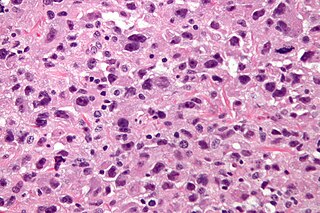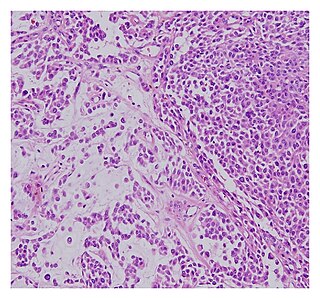| Atypical fibroxanthoma | |
|---|---|
| Specialty | Oncology, rheumatology |
Atypical fibroxanthoma of the skin is a low-grade malignancy related to malignant fibrous histiocytoma, which it resembles histologically. [1] :613
| Atypical fibroxanthoma | |
|---|---|
| Specialty | Oncology, rheumatology |
Atypical fibroxanthoma of the skin is a low-grade malignancy related to malignant fibrous histiocytoma, which it resembles histologically. [1] :613
Surgical excision with clear margins.[ citation needed ]
It occurs most commonly on the skin of sun-exposed, elderly patients. The majority of tumours are on the scalp, face, ears and upper limbs, but less commonly the tumour occurs on the limbs and trunk when there is a lack of association with sun exposure in younger individuals. The condition has also been noted in organ transplant recipients who may be in a state of immunosuppression. It has been reported that there is a predominance in men (70% men versus 30% women). [2]

A lipoma is a benign tumor made of fat tissue. They are generally soft to the touch, movable, and painless. They usually occur just under the skin, but occasionally may be deeper. Most are less than 5 cm in size. Common locations include upper back, shoulders, and abdomen. A few people have a number of lipomas.

A sarcoma is a malignant tumor, a type of cancer that arises from transformed cells of mesenchymal origin. Connective tissue is a broad term that includes bone, cartilage, fat, vascular, or hematopoietic tissues, and sarcomas can arise in any of these types of tissues. As a result, there are many subtypes of sarcoma, which are classified based on the specific tissue and type of cell from which the tumor originates. Sarcomas are primary connective tissue tumors, meaning that they arise in connective tissues. This is in contrast to secondary connective tissue tumors, which occur when a cancer from elsewhere in the body spreads to the connective tissue. The word sarcoma is derived from the Greek σάρκωμα sarkōma "fleshy excrescence or substance", itself from σάρξ sarx meaning "flesh".

A bone tumor is a neoplastic growth of tissue in bone. Abnormal growths found in the bone can be either benign (noncancerous) or malignant (cancerous).

Serous tumours are part of the surface epithelial-stromal tumour group of ovarian tumors, which derive from Mullerian epithelium. They are common neoplasms with a strong tendency to occur bilaterally, and they account for approximately a quarter of all ovarian tumors.

Fibromas are benign tumors that are composed of fibrous or connective tissue. They can grow in all organs, arising from mesenchyme tissue. The term "fibroblastic" or "fibromatous" is used to describe tumors of the fibrous connective tissue. When the term fibroma is used without modifier, it is usually considered benign, with the term fibrosarcoma reserved for malignant tumors.
A dermatofibroma, or benign fibrous histiocytomas, is a benign skin growth.

Fibrosarcoma is a malignant mesenchymal tumour derived from fibrous connective tissue and characterized by the presence of immature proliferating fibroblasts or undifferentiated anaplastic spindle cells in a storiform pattern. It is usually found in males aged 30 to 40. It originates in fibrous tissues of the bone and invades long or flat bones such as the femur, tibia, and mandible. It also involves the periosteum and overlying muscle.
The International Classification of Diseases for Oncology (ICD-O) is a domain-specific extension of the International Statistical Classification of Diseases and Related Health Problems for tumor diseases. This classification is widely used by cancer registries.
The oral mucosa is the mucous membrane lining the inside of the mouth. It comprises stratified squamous epithelium, termed "oral epithelium", and an underlying connective tissue termed lamina propria. The oral cavity has sometimes been described as a mirror that reflects the health of the individual. Changes indicative of disease are seen as alterations in the oral mucosa lining the mouth, which can reveal systemic conditions, such as diabetes or vitamin deficiency, or the local effects of chronic tobacco or alcohol use. The oral mucosa tends to heal faster and with less scar formation compared to the skin. The underlying mechanism remains unknown, but research suggests that extracellular vesicles might be involved.
Malignant histiocytosis is a rare hereditary disease found in the Bernese Mountain Dog and humans, characterized by histiocytic infiltration of the lungs and lymph nodes. The liver, spleen, and central nervous system can also be affected. Histiocytes are a component of the immune system that proliferate abnormally in this disease. In addition to its importance in veterinary medicine, the condition is also important in human pathology.
A histiocytoma is a tumour consisting of histiocytes. Histiocytes are cells that are a part of the mononuclear phagocytic system, a part of the body's immune system that consists of phagocytic cells, which are responsible for engulfing solid particles by the cell membrane to form an internal phagosome by phagocytes and protists.

A histiocytoma in the dog is a benign tumor. It is an abnormal growth in the skin of histiocytes (histiocytosis), a cell that is part of the immune system. A similar disease in humans, Hashimoto-Pritzker disease, is also a Langerhans cell histiocytosis. Dog breeds that may be more at risk for this tumor include Bulldogs, American Pit Bull Terriers, American Staffordshire Terriers, Scottish Terriers, Greyhounds, Boxers, and Boston Terriers. They also rarely occur in goats and cattle.

Undifferentiated pleomorphic sarcoma, previously malignant fibrous histiocytoma, is a type of cancer, namely a soft-tissue sarcoma.
Malignant rhabdoid tumour (MRT) is a very aggressive form of tumour originally described as a variant of Wilms' tumour, which is primarily a kidney tumour that occurs mainly in children.
Soft tissue sarcoma refer to a broad group of tumors that originate from connective tissues. They tend to have similar histologic appearance and biological behavior, and can be either benign or malignant. Soft tissue sarcomas can arise in any part of the pet's body but skin and subcutaneous tumors are the most commonly observed. Soft-tissue sarcomas comprise approximately 15% of all skin and subcutaneous tumors in dogs and approximately 7% of all skin and subcutaneous tumors in cats. The variety of different tumors that fall under the category of soft tissue sarcomas includes fibrosarcoma, hemangiopericytoma, liposarcoma, rhabdomyosarcoma, leiomyosarcoma, malignant fibrous histiocytoma, malignant nerve sheath tumors, myxosarcoma, myxofibrosarcoma, mesenchymoma, and spindle cell tumor.

Carcinosarcomas are malignant tumors that consist of a mixture of carcinoma and sarcoma. Carcinosarcomas are rare tumors, and can arise in diverse organs, such as the skin, salivary glands, lungs, the esophagus, pancreas, colon, uterus and ovaries.
Malignant fibrous cytoma is a soft tissue sarcoma that usually occurs in the limbs, most commonly the legs, and may also occur in the abdomen. Also called malignant fibrous histiocytoma.

A malignant chondroid syringoma is a very uncommon cutaneous (skin) condition characterised by an adnexal eccrine tumour.

The following is a simplified (deprecated) version of the last 2007 WHO classification of the tumours of the central nervous system. Currently, as of 2016, clinicians are using revised WHO grade 4th edition which incorporates recent advance in molecular pathology. The 4th revised edition, as the name implies, will soon be updated to catch up ever growing knowledge of this field.
Histiocytic diseases in dogs are a group of diseases in dogs which may involve the skin, and which can be difficult to differentiate from granulomatous, reactive inflammatory or lymphoproliferative diseases. The clinical presentation and behaviour as well as response to therapy vary greatly among the syndromes.
Text copied under the terms of the CC-by license, see source.
| Classification |
|---|
| This Dermal and subcutaneous growths article is a stub. You can help Wikipedia by expanding it. |